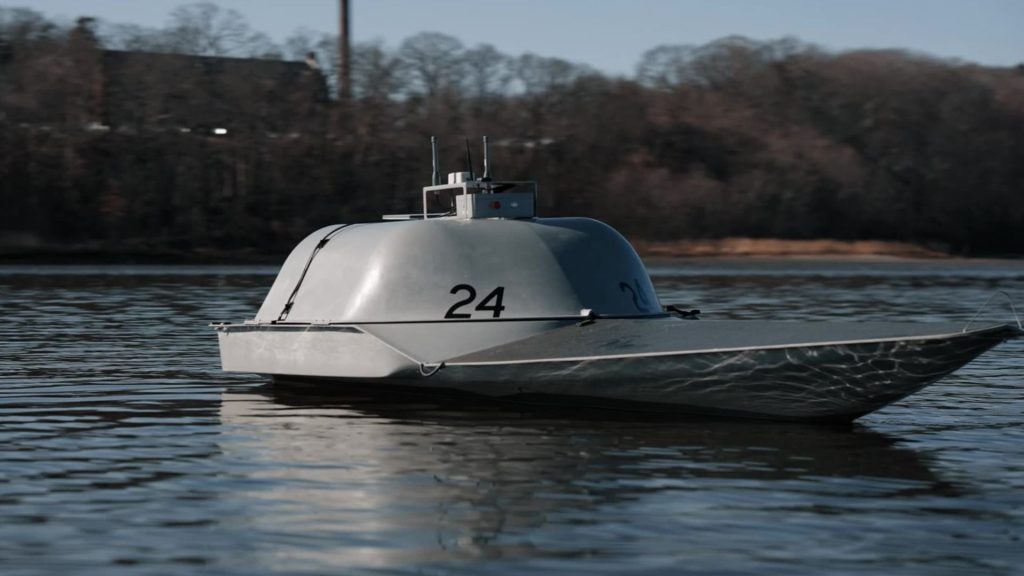How one company wants to help the US Navy create a ‘hellscape’ in the Pacific

The U.S. military is ramping up preparations in the Pacific to deter or counter China and its potential invasion of Taiwan in 2027. Central to its strategy is deploying thousands of autonomous sea drones that would create a robotic defense network across the Taiwan Strait. The strategy is dubbed “Hellscape.”
A rapid strike — and a rapid response
Adm. Samuel Paparo, commander of U.S. Indo-Pacific Command, warned in a 2024 interview with The Washington Post that if China decides to attack, it will try to do so with overwhelming speed and force. The goal would be to seize Taiwan before the U.S. or its allies could intervene.
Paparo believes the key to countering such an assault lies in disrupting the initial wave of attacks across the 100-mile-wide waterway separating Taiwan from mainland China. To do this, the U.S. would need to pre-position thousands of unmanned surface and subsurface vessels in the region. These robotic platforms would act as a front-line defense, stalling enemy ships long enough to allow Taiwan, the U.S. and allied forces to mount a coordinated response.
Rep. Rob Wittman, R-Va., speaking at the 2025 Sea, Air, Space Defense Conference, emphasized the tactical complexity this poses for Beijing.
“All of the sudden, the risk calculation for the Chinese gets very, very complicated,” he said. “This is an away game for them. You’re going to fight with what you’ve got when the balloon goes up, and if we’ve got enough assets inside the First Island Chain, China might say, ‘maybe not today.’”
Rep. Trent Kelly, R-Miss., echoed that urgency, noting the importance of adapting commercial technology for military use more quickly than the U.S. defense sector is used to.
“We’ve got to do a better job of building things that are commercial and adapting those to military use,” Kelly said. “Eighty percent of what goes into a commercial ship is the same as a military one. So why are we redesigning systems that already work?”
HAVOCai and the rise of tactical autonomy
One company hoping to answer that challenge is HAVOCai, a startup founded by former U.S. Navy aviator Paul Lwin. A refugee from Burma, now known as Myanmar, who came to the U.S. as a child, Lwin was inspired to join the service by the sense of safety he felt seeing the U.S. Marines for the first time at the embassy that helped his family flee.
After leaving the military, Lwin worked in the defense industry and began developing software for tactical autonomy, or the technology that allows unmanned vehicles to operate and coordinate independently in real-world environments. In early 2024, he attended a defense conference where Undersecretary of Defense Heidi Shyu spoke about the Pentagon’s Replicator Initiative. The initiative is the DOD’s primary plan to field thousands of low-cost autonomous systems in the coming years.
“There was one thing she said that stuck with me,” Lwin recalled. “She said, ‘All we want is a company to build boats, make them robotic, and make them work together.’ And I thought, ‘I know how to do that.’”
The next day, he quit his job and launched HAVOCai.
The Rampage: A smart, solar-powered maritime drone
HAVOCai’s flagship vehicle is the Rampage, a 14-foot-long unmanned boat that can carry a 300-pound payload. The craft is versatile enough for surveillance or weapon deployment and is built to be self-righting, making it more resilient in rough Pacific conditions.
“Everything we put on the boat is commercially available,” Lwin said. “That is important. If you try to build it yourself, like a lot of companies do, they reinvent things that already exist. We want to keep the costs down and make the reliability high. The only way to do that is to use things that exist in the commercial markets.”
HAVOCai does own the Rampage design, though, and contracts with a manufacturer in Rhode Island to build them. While the physical vessel is impressive, HAVOCai’s real innovation lies in the artificial intelligence software that powers the system.
According to Lwin, many competitors have tested only one or two boats with limited autonomy. HAVOCai took a different approach by deploying its boats repeatedly in the field to gather performance data and improve software.
In 18 months, HAVOCai built 42 Rampages. Thirty-two of those are already assigned to customers, including the Department of Defense. They’re solar-powered, they recharge in about five hours, and they’re cost-effective.
With a base price of roughly $100,000, the Rampage costs one-tenth of what competing systems do. That affordability, combined with its long-range capabilities, makes it ideal for creating a vast sensor and surveillance web across the Pacific.
“Instead of relying on one guided missile destroyer to monitor a thousand miles of ocean, we can deploy 100 boats across that same distance,” Lwin said. “It’s more resilient, harder to defeat, and offers much higher sensor fidelity.”
Scaling the future of autonomy
HAVOCai is already proving its capability to scale. In a recent test, the company operated 25 vessels simultaneously from a control center in San Diego. The vessels were deployed across the globe, from Europe to the U.S. Atlantic and Pacific coasts, and all under observation from over 150 Department of Defense officials.
“That had never been done, and we did it,” Lwin said. “If you think about the Pacific Ocean, it’s 8,000 miles wide, right? You’re going to have thousands of autonomous assets that have to be operated, and you can’t do one person to one autonomous asset. That doesn’t make sense, and that’s not the value autonomy provides. What you want is one person monitoring a thousand assets.”
Right now, HAVOCai is regularly operating 25 autonomous craft at a time. This summer, the company plans to scale that up to 100. With DOD support, Lwin says they’ll be controlling swarms of a thousand or more by next summer.
In addition to refining the artificial intelligence agent that controls Rampage, HAVOCai is developing a larger, 40-foot model called the Sea Hound, which will carry up to 1,000 pounds and is set for sea trials in early 2026. Importantly, both vessels operate on the same AI agent, which Lwin said is size and vehicle-agnostic.
“Our software doesn’t care what type of boat it is or how big it is. It honestly doesn’t care that it is a boat. You’re going to see us put our software on larger and larger vessels. All the way up to ships and on other platforms like UAVs, UGVs, and UUVs,” Lwin said, using the industry acronyms for Unmanned Aerial Vehicles, Unmanned Ground Vehicles, and Unmanned Underwater Vehicles, respectively.
As tensions in the Indo-Pacific rise, the marriage of scalable autonomy and low-cost hardware could play a decisive role in shaping future conflicts. With its fast-moving approach, HAVOCai hopes to position itself as a key player in the Pentagon’s evolving strategy to defend Taiwan and challenge adversaries with a fleet of intelligent machines.





